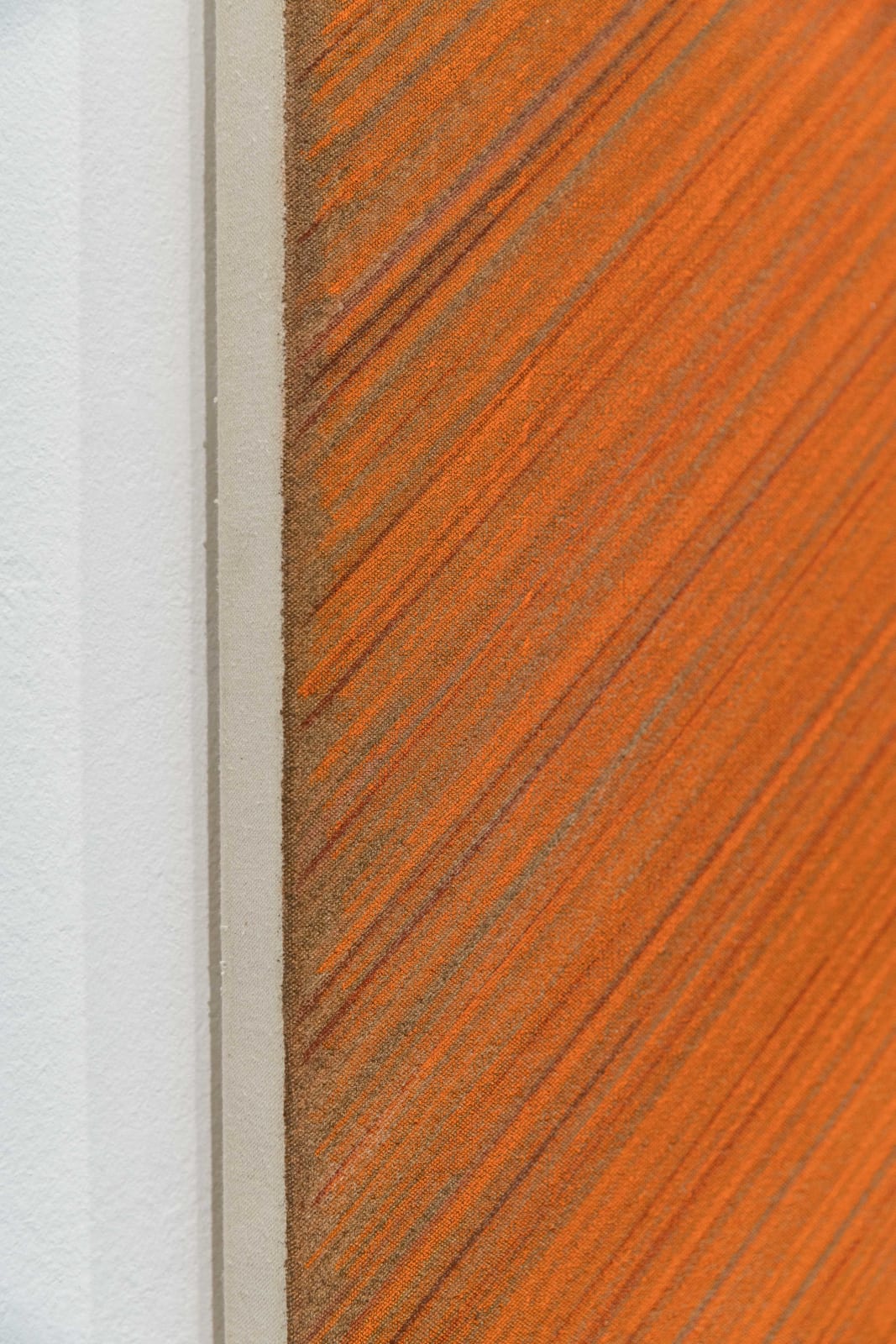Rosemarie Castoro
Orange China Marker, 1967
Acrylic, prismacolor pencils, china marker and graphite on canvas
212.1 x 210.5 cm
83 1/2 x 82 7/8 inches
83 1/2 x 82 7/8 inches
Signed on backside "R Castoro 1967"
© The Estate of Rosemarie Castoro
Photo: Dirk Tacke
Weitere Abbildungen
Das großformatige Gemälde Orange China Marker (1967) steht am Ende einer Serie abstrakter Gemälde von Rosemarie Castoro, die im Verlauf der Sechziger Jahre zunehmend monochromer wurde und in welcher die...
Das großformatige Gemälde Orange China Marker (1967) steht am Ende einer Serie abstrakter Gemälde von Rosemarie Castoro, die im Verlauf der Sechziger Jahre zunehmend monochromer wurde und in welcher die Struktur des Farbauftrags, als auch die Verwendung der Linie immer stärker hervortritt.
Diese Malereien, welche häufig auch Prismacolor Paintings oder Pencil Paintings genannt werden, zeichnen sich mit ihren durchdringenden monochromen Flächen durch die dichte Wiederholung paralleler Linien aus. In Orange China Marker ist die orange Farbe diagonal von der linken unteren Ecke in die rechte obere Ecke aufgetragen. Überzeichnungen mit Prismacolor-Buntstiften, Wachsmalkreide (China Marker) und Bleistift überlagern die Pinselstriche und führen zu einem schimmernden Moiré-Effekt.
Castoros Verwendung der Bleistiftlinie als sichtbarer Bestandteil der Malerei erinnert an das Werk der minimalistischen Malerin Agnes Martin (1912-2004), die sie zu dieser Zeit kennenlernte. Die Leinwand zeugt von Castoros erweitertem Verständnis von Malerei und Zeichnung, in dem Gattungsgrenzen verwischt und der traditionelle Medienbegriff umgeschrieben wird.
Wie auch bei der Arbeit Two Blues Band (1965) ist der Titel Orange China Marker ganz im Sinne der Minimal Art wörtlich zu verstehen und verweist auf die Farbigkeit und Technik des Gemäldes.
The large-format painting Orange China Marker (1967) is the final work in a series of abstract paintings by Rosemarie Castoro, which became increasingly monochrome over the course of the sixties and in which the structure of the paint application as well as the use of the line becomes increasingly distinctive. These paintings, often referred to as Prismacolor Paintings or Pencil Paintings, are characterized by the dense repetition of parallel lines with their pervasive monochrome surfaces. In Orange China Marker, the orange color is applied diagonally from the lower left corner to the upper right corner. Drawings with prismatic colored pencils, wax crayons (China Marker) and pencil overlay the brushstrokes and lead to a shimmering moiré effect.
Castoro's use of the pencil line as a visible part of the painting is reminiscent of the work of minimalist painter Agnes Martin (1912-2004), whom she was associated with during that time. The canvas bears witness to Castoro's expanded understanding of painting and drawing, in which genre boundaries are blurred and the traditional concept of media is rewritten.
As in the work Two Blues Band (1965), the title Orange China Marker is to be understood literally in the sense of Minimal Art and refers to the colorfulness and technique of painting.
Diese Malereien, welche häufig auch Prismacolor Paintings oder Pencil Paintings genannt werden, zeichnen sich mit ihren durchdringenden monochromen Flächen durch die dichte Wiederholung paralleler Linien aus. In Orange China Marker ist die orange Farbe diagonal von der linken unteren Ecke in die rechte obere Ecke aufgetragen. Überzeichnungen mit Prismacolor-Buntstiften, Wachsmalkreide (China Marker) und Bleistift überlagern die Pinselstriche und führen zu einem schimmernden Moiré-Effekt.
Castoros Verwendung der Bleistiftlinie als sichtbarer Bestandteil der Malerei erinnert an das Werk der minimalistischen Malerin Agnes Martin (1912-2004), die sie zu dieser Zeit kennenlernte. Die Leinwand zeugt von Castoros erweitertem Verständnis von Malerei und Zeichnung, in dem Gattungsgrenzen verwischt und der traditionelle Medienbegriff umgeschrieben wird.
Wie auch bei der Arbeit Two Blues Band (1965) ist der Titel Orange China Marker ganz im Sinne der Minimal Art wörtlich zu verstehen und verweist auf die Farbigkeit und Technik des Gemäldes.
The large-format painting Orange China Marker (1967) is the final work in a series of abstract paintings by Rosemarie Castoro, which became increasingly monochrome over the course of the sixties and in which the structure of the paint application as well as the use of the line becomes increasingly distinctive. These paintings, often referred to as Prismacolor Paintings or Pencil Paintings, are characterized by the dense repetition of parallel lines with their pervasive monochrome surfaces. In Orange China Marker, the orange color is applied diagonally from the lower left corner to the upper right corner. Drawings with prismatic colored pencils, wax crayons (China Marker) and pencil overlay the brushstrokes and lead to a shimmering moiré effect.
Castoro's use of the pencil line as a visible part of the painting is reminiscent of the work of minimalist painter Agnes Martin (1912-2004), whom she was associated with during that time. The canvas bears witness to Castoro's expanded understanding of painting and drawing, in which genre boundaries are blurred and the traditional concept of media is rewritten.
As in the work Two Blues Band (1965), the title Orange China Marker is to be understood literally in the sense of Minimal Art and refers to the colorfulness and technique of painting.





